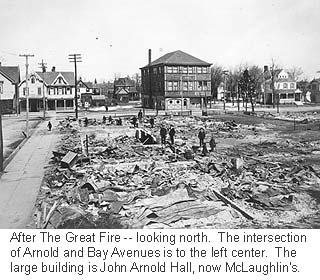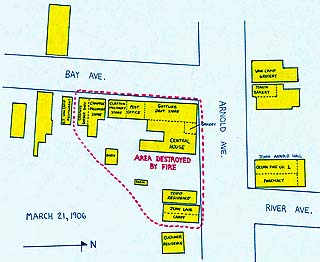| The heart of the business
district destroyed in The Great Fire of 1906 Point Pleasant Beach was devastated. Firefighters had to use a bucket brigade because fire hydrants had not yet been installed. The damage estimate was a staggering $82,000. Timelines | Pt. Pleasant Historical Society | Pt. Pleasant History | Images | Sites | Books | Tidbits | End | Send Mail  Point
Pleasant Beach has had its share of fires over the years, many of large
proportions. When talking about large fire in town, most residents think
back to the boardwalk fires of 1975, Vannote Lumber in 1968, or even the
Hotel Arnold fire in 1956. But most likely the largest fire to strike
the town as far as size, the number of people left homeless and the
effect on the local economy, occurred way back in 1906. Point
Pleasant Beach has had its share of fires over the years, many of large
proportions. When talking about large fire in town, most residents think
back to the boardwalk fires of 1975, Vannote Lumber in 1968, or even the
Hotel Arnold fire in 1956. But most likely the largest fire to strike
the town as far as size, the number of people left homeless and the
effect on the local economy, occurred way back in 1906.
During the first twenty years of Point Pleasant Beach's existence, Bay Avenue was considered the "main street" in town, containing a majority of businesses, with the corner of Bay and Arnold the prime intersection. At this intersection in 1906 stood a large wooden building on the
southeast corner containing a rooming house, three stores and the post
office. Originally named the Eureka Building it was built by Captain
John Arnold in 1879 and also contained several apartments above the
stores. The Polhemus family, occupying the apartment above the post office, experienced trouble starting their stove. After lighting the fire, the stove refused to draw. Planning to restart the fire in the morning, the occupants retired for the night. However, the stove did finally take fire and with the flue wide open and loaded with wood, it became overheated and ignited the adjacent wall and ceiling. At 12:15 a.m. the fire alarm was turned in to Ocean Fire Company #1, located in John Arnold Hall across from Arnold Avenue. Ten minutes later the chemical engine and fire apparatus were set up in front of the burning building. The first men at the scene immediately evacuated the boarding house and ran up the rear stairway to the Polhemus and Gottlieb apartments. The Polhemus family was unaware of the fire and was awakened and carried out, including two children. Michael Gottlieb, his wife and three children found their route of escape cut of by the flames and went to one of the front windows where they attracted attention from the street. They were brought down a ladder clad only in their nightclothes. While these rescues were taking place, mail and equipment were removed from he post office and brought to Makin's bakery where the post office resumed operation the next day. With evacuations completed, firefighters turned their full attention to the growing blaze. The fire was spreading rapidly through the entire Eureka building and ignited a barn in the rear. The firemen realized at this point they were unable to cope with the blaze and summoned help from Manasquan and Spring Lake, the two nearest companies. A fifty foot open space was between the Central House and the Todd residence on Arnold Avenue and firemen attempted to keep the fire at bay with no luck. Flames leaping 75 feet into the night skies soon ignited the Todd building along with a second barn to the rear. Councilman John Laug's candy factory was next to the burning Todd House and it too caught fire. The battle was not only against a growing conflagration, but the strong winds carried burning embers and shingles over a large area of the town to the east, which had to be watched closely. On Bay Avenue, the south end of the blazing Eureka building was separated by a narrow alley from a three story building containing two stores and apartments. This building soon joined the mass of flames. By this time, help from Manasquan and Spring Lake arrived and total attention was turned to the surrounding buildings. Bucket brigades were set up in addition to the three chemical trucks at the restaurant of E.T. VanCamp on Bay Avenue and at the recently build George Clickner house on Arnold Avenue. It was at these two spots that the fire finally checked. On the opposite side of Arnold Avenue, firefighters frantically worked to save their own building as wall as the bakery. Arnold Hall was damaged by the intense heat which cracked the plate glass windows but was kept from catching fire. Makin's bakers and Van Camp's grocery were scorched but were also saved. By dawn the next day, all of the involved buildings were reduced to the foundations. A total of four buildings and two barns were completely lost, but no serious injuries were sustained. the Gottlieb department store had just been stocked the week before and took a loss of $12,000. The remaining businesses totaled over $70,000 in losses, a staggering figure in 1906. One of the main factors in hampering firefighters was the lack of available water to fight the fire. Fire hydrants were not yet installed in town, while the chemical engines were useless against a large fire. Many other large fires plagued Point Pleasant Beach during the first dozen years of the century, but the benefit of hydrants, better equipment, experience, and an additional fire company emerged from the ashes of the Great Fire.
— By Jerry Woolley
Timelines | Pt. Pleasant Historical Society | Pt. Pleasant History | Images | Sites | Books | Tidbits | Top | Send Mail |
